Sliced Tree Bowl
By Mike on Sunday, April 17, 2016, 15:42 - Permalink
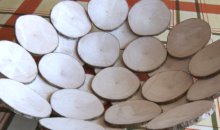
This is a project based on a woodworking technique that I discovered (or maybe invented!) completely by accident.
It's a wooden bowl made from slices of tree trunk - the clever part is that nature provides the curvature...
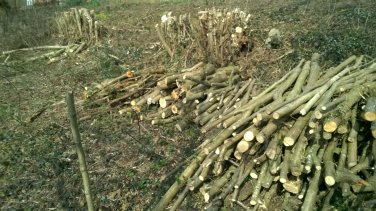
It started with some coppiced hazel sticks - near where I live, the local council had cut down a mixed hardwood hedgerow - including some hazel coppice yielding very straight sticks in a variety of diameters from about 5cm to 15cm.
I'm fairly sure these poles will either just be left to rot (which isn't necessarily a bad thing - it's good for wildlife), or they will be chipped and hauled off for disposal.
I grabbed a small selection of them for some small-scale woodworking projects.

The wood is still 'green' (full of natural moisture) so can't be used for ordinary woodworking purposes, but it is possible to turn items on the lathe from green, and I intended to do this.
In order to square off the base of one of the pieces I had already cut, I had to slice a very thin piece off the end.
The resulting piece was very lovely - translucent in its wet state and it was possible to see the rings and medullary rays through the wood when it was held up to the light.
Because it was a curiosity, I brought it indoors and set it flat on a table. The next day, a surprising change had taken place.

The piece had acquired a curious cupped shape - concave on the upper side that had been exposed to the air, convex on the underside that had been flat against the table.
I expected this effect to even itself out (and the piece to return to a flat disc when fully dried on both sides), but it didn't.
The disc, once completely dry (which only took a week, as it was so thin) retained its cupped shape. Immediately, ideas started forming in my head.
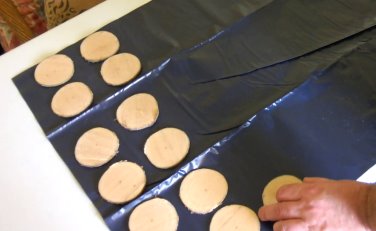
I cut another 25 or so thin slices of green hazel log. To accentuate the cupping, I lightly sponged one side of each, and laid them, wet side down, on a sheet of plastic.
I left them there for a week - and sure enough, they all did the same thing as the original slice - they curled up at the edges, each forming a tiny bowl.
Why Did The Wood Curl Up?
Wood is composed of longitudinal fibres (that is, running up and down parallel with the axis of the trunk)
These shrink across their thickness (but not their length) when they dry out - and expand when they get wet - as a result, a piece of wood will swell up in directions perpendicular to the grain when it gets wet.
This wood was already wet with the natural moisture that exists in fresh green wood. Placing the pieces flat on the table means that the exposed upper side could dry out and shrink faster than the underside, where moisture was trapped and prevented from leaving.
So the top side of the discs shrank, pulling up the edges - it is quite surprising that this didn't result in the formation of cracks, but it didn't.

Of course, a collection of tiny bowls is still not a lot of use like that, however, I had an idea, but first, they would need to be tidied up a little.

I carefully sanded the concave side of each one using an 80 grit flap wheel sanding accessory, mounted in an electric drill. This is a coarser sanding grit than I would have liked, but the finest I could find as a flap wheel, so it would have to do. I just took it gently, and the finish still came out nice and smooth,
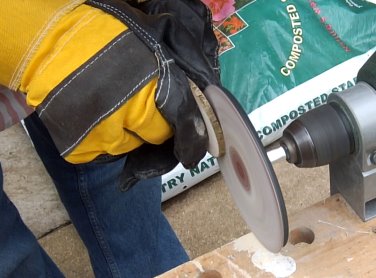
The convex side of the pieces was easier - I sanded this smooth against a drill-mounted sanding disc.
The gloves were a worthwhile precaution, by the way - I thought I wouldn't need them, but looking at the condition of the leather after I had finished sanding all of the wooden discs on both sides, I reckon I would have lost a fair bit of skin and a couple of fingernails if I had not worn the gloves.
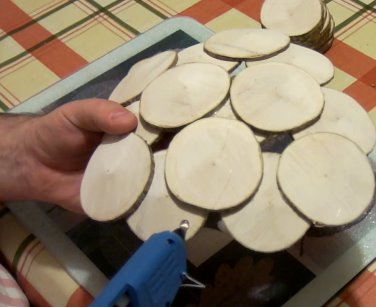
Now it was time to start assembling my plan. I used a hot melt glue gun to stick the discs together in an overlapping pattern.
The individual small curvature of each piece very quickly compounds to form a bowl-like assembly.
It all went together very nicely, although the end result is not exactly regular - there are a few gaps and wrong overlaps, but still the effect works.
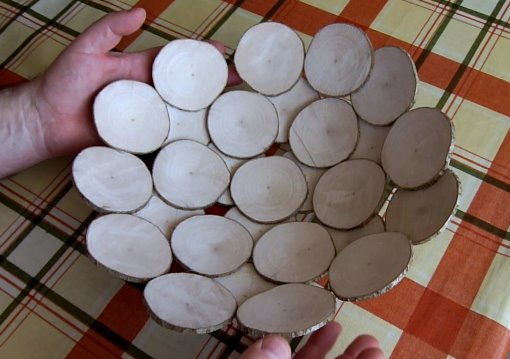
As a proof of concept, I am actually quite thrilled and excited by this - and I still have a number of the hazel logs left, so I have aple opportunity to try again - in fact, this is an incredibly economical method of making an object - it only consumed about 25cm of the hazel pole, but has made a bowl that is more than 30cm in diameter.
I think with a little more care in construction, it would make a good fruit bowl or serving basket for bread - despite being thin and light, it feels quite strong.
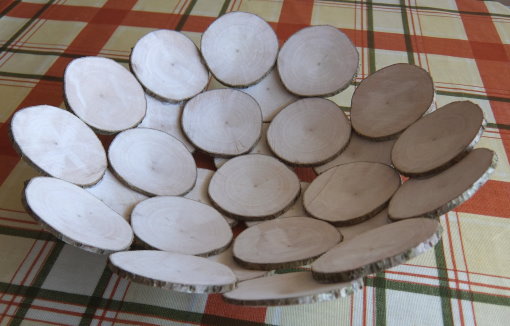
Video
Here's a video showing a little more detail of the methods of construction of this experimental bowl:
